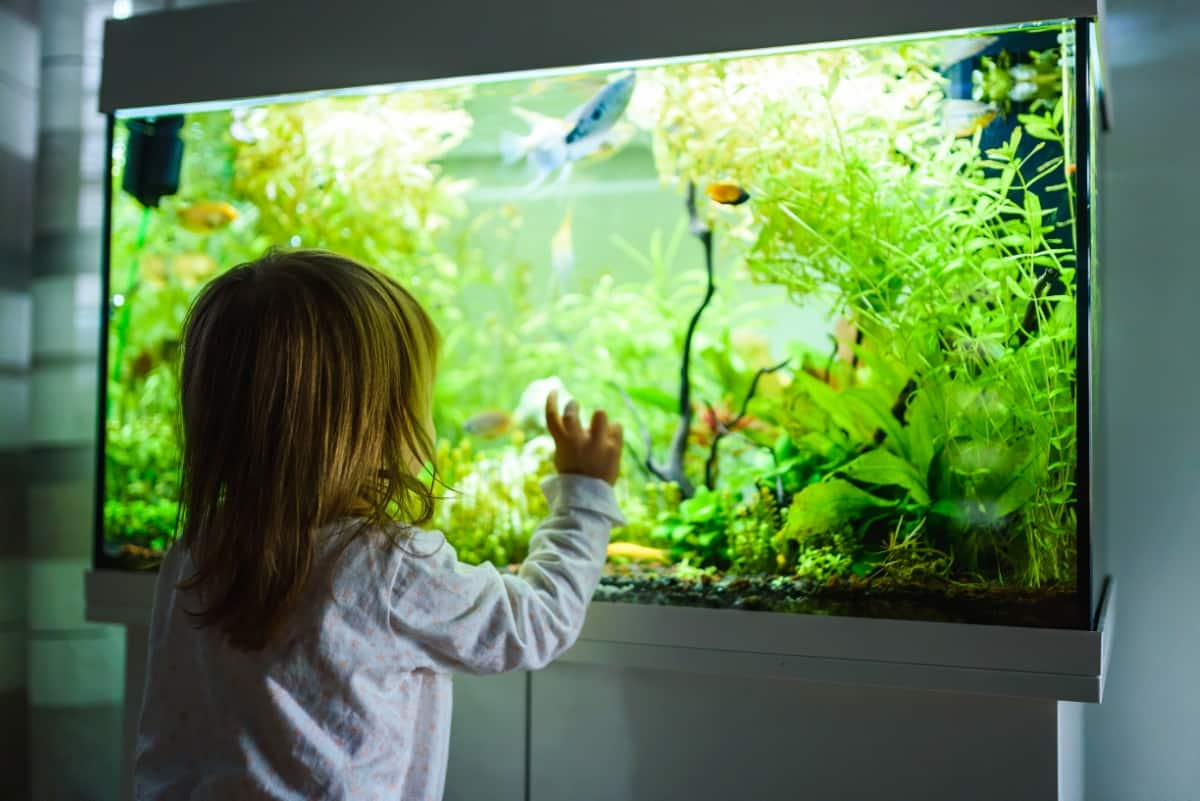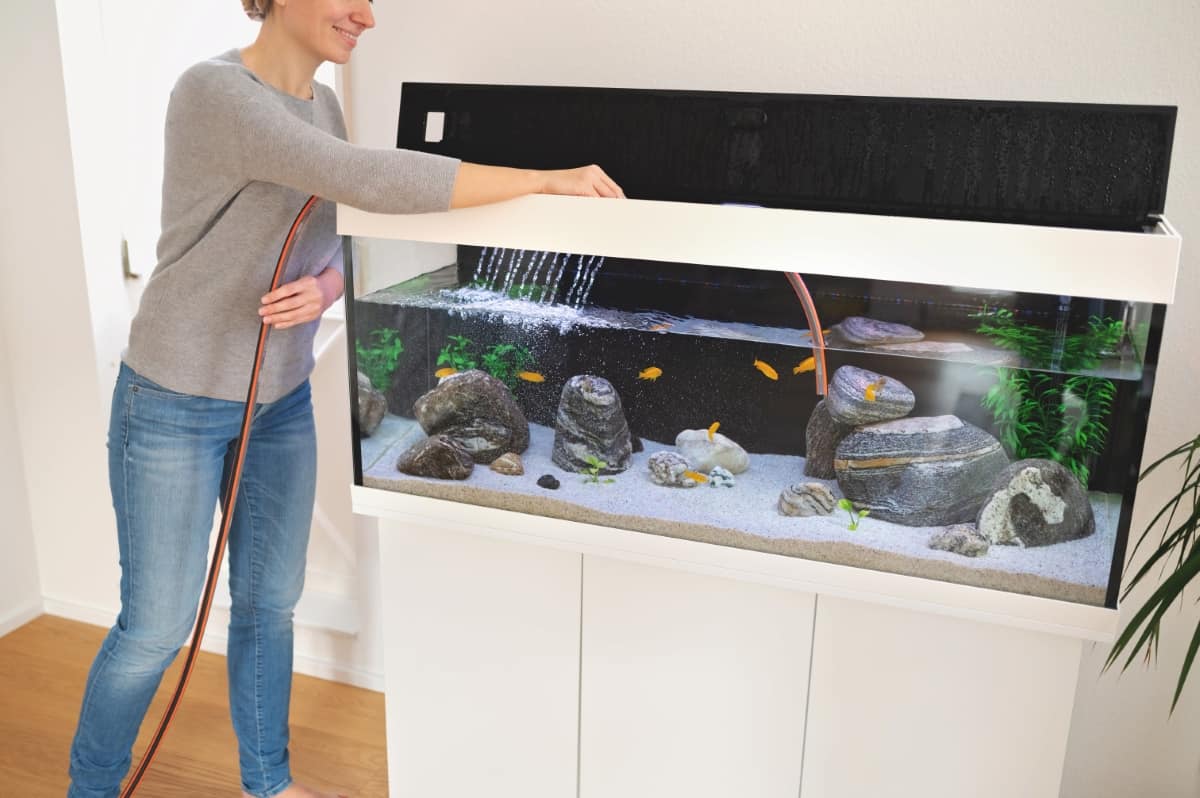Setting up a fish tank in apartments can be a rewarding experience, offering a slice of aquatic life in a small space. This apartment fish tank setup guide is designed to navigate you through the essentials of establishing a compact aquarium, ensuring it fits well in limited spaces. From choosing the best fish tanks for apartments to understanding the nitrogen cycle in fish tanks, this beginner’s guide to aquarium setup will cover all you need to know.

Space-saving fish tank designs, apartment-friendly fish species, and essential aquarium equipment for beginners are just the tip of the iceberg. With the right approach, aquascaping for apartment aquariums can become a fulfilling hobby, enhancing your living space with a serene aquatic ambiance.
Set up a Fish Tank in Apartments
Step 1: Choosing the Right Tank
Size Considerations
When selecting a small fish tank for an apartment, size is crucial. Typically, tanks ranging from 5 to 20 gallons are ideal for small spaces, offering enough room for various apartment-friendly fish species without overwhelming the area. Select compact aquariums for limited spaces according to available area and desired aquatic inhabitants, maintaining harmony between visual appeal and the welfare of the tank’s occupants.
Type of Fish Tank
Glass tanks are a classic choice, offering clear visibility and a timeless look, suitable for a wide range of fish species, including betta fish, neon tetras, and guppies. On the other hand, acrylic tanks are lighter and more impact-resistant, making them a great option for high-traffic areas or if you plan to move the tank occasionally. They are also well-suited for the same beginner-friendly, apartment-friendly fish species due to their versatility in shape and size, allowing for creative aquascaping that caters to the needs of these small and peaceful fish.
Step 2: Selecting a Suitable Location
Space and Accessibility
The ideal space for an apartment fish tank setup should be stable, level, and capable of supporting the weight of a fully equipped aquarium, which can be substantial when filled with water. A standard 10-gallon tank might need a space of at least 20×10 inches for the tank’s footprint, with additional room for equipment access and maintenance activities.
Avoiding Direct Sunlight and Drafts
Placing your fish tank away from direct sunlight and drafts is crucial to prevent algae growth and maintain stable water temperatures. Direct sunlight can cause temperature fluctuations and promote algae growth, challenging tank maintenance. A location away from windows and heating or cooling vents will provide a more controlled environment for your aquatic setup.
Step 3: Gathering Essential Equipment
Filtration System
A dependable filtration system is vital to maintain water cleanliness and oxygen levels, ensuring optimal conditions for fish health. Water filtration systems for small aquariums come in various forms, including hang-on-back and internal filters, each suitable for different tank sizes and setups.
Heating and Lighting
Ensuring optimal water temperature is essential for the well-being of your fish, underscoring the importance of investing in a high-quality aquarium heater. Similarly, appropriate lighting solutions for apartment aquariums enhance the visual appeal of your setup and support the health of any live plants. LED lights are favored for their energy efficiency and long lifespan, offering a versatile spectrum of light ideal for supporting both aquatic life and plant growth.
In case you missed it: Top 10 Common Mistakes to Avoid in Fish Farming

Step 4: Setting Up the Tank
Placing the Tank
Once you’ve selected the perfect spot, placing the tank on a sturdy, level surface is the first step in your setup. Ensure the area is clutter-free and provides enough space for the tank’s dimensions, allowing for easy access for maintenance. A dedicated aquarium stand or a robust piece of furniture can serve as a solid base, ensuring the safety and stability of your aquatic setup.
Adding Substrate
Adding substrate to your tank enhances its aesthetic appeal and supports plant life and beneficial bacteria growth. From gravel to specialized aquatic plant substrates, choosing the right type depends on your aquascaping plans and the needs of your chosen fish species. A layer about 1-2 inches thick is usually sufficient, providing a foundation for plants and decorations while allowing for effective water flow and filtration.
Step 5: Installing Equipment
Setting Up the Filter
Installing your filtration system correctly is crucial for maintaining water quality and clarity. Follow the manufacturer’s instructions carefully, ensuring the filter is securely attached and positioned for optimal water flow. The filter should be easily accessible for regular cleaning and maintenance, contributing to a healthy tank environment.
Heater Installation
Place the heater close to the water flow from the filter for even heat distribution. Regularly utilize an aquarium thermometer to monitor water temperature, adjusting heater settings to ensure optimal conditions for aquatic residents.
Lighting Setup
Setting up your aquarium lighting involves choosing fixtures that fit your tank’s size and the needs of your plants and fish. LED fixtures with adjustable intensity and color spectrum can mimic natural daylight cycles, promoting healthy plant growth and fish behavior. Ensure the lights are positioned to illuminate the tank evenly while avoiding excessive light exposure that could encourage algae growth.
Step 6: Adding Water and Conditioning
Filling the Tank
Carefully fill your tank with dechlorinated or specially treated aquarium water, avoiding disturbing the substrate and decorations. Pouring water over a plate or saucer placed on the substrate can help minimize disruption. Leave space at the top of the tank to prevent overflow once equipment and living inhabitants are added.
Water Conditioning
Treating tap water with a water conditioner is essential to remove harmful chemicals like chlorine and chloramines, making it safe for your fish. Water conditioning also helps set up the right environment for the nitrogen cycle to begin, which is vital for converting harmful waste products into less toxic substances and ensuring the health and safety of your aquarium ecosystem.
Step 7: Cycling the Tank
Understanding the Nitrogen Cycle
Cycling your tank is crucial for establishing beneficial bacterial colonies that convert ammonia from fish waste into nitrites and nitrates, which are less harmful to fish. This process, known as the nitrogen cycle, can take several weeks and is essential for creating a stable environment in your aquarium. Adding a small number of hardy fish or ammonia sources can initiate the cycle, but regular testing of water parameters is crucial to monitor progress.
Monitoring Water Parameters
Frequent testing for ammonia, nitrites, and nitrates is crucial throughout the cycling phase and afterward to maintain optimal aquarium health. Water testing kits are conveniently accessible and simple, offering valuable information about your tank’s environmental status.
Step 8: Aquascaping
Choosing Plants and Decorations
Selecting the right plants and decorations for your tank involves considering both aesthetic appeal and the environmental needs of your fish. Live plants can enhance water quality and provide hiding places for fish, while decorations should be chosen for their safety and compatibility with your tank’s inhabitants.
Layout and Design
Planning your aquascape involves arranging plants and decorations in a way that is visually pleasing while allowing for ample swimming space and territories for your fish. When designing, incorporate foreground, midground, and background elements to enhance depth and visual appeal. Utilize taller vegetation and décor in the rear, with shorter items in the forefront.
In case you missed it: Fish Farming Regulations and Permits: Every First-Time Fish Farmer Should Know These

Step 9: Introducing Fish
Selecting Suitable Species
When introducing fish to your apartment aquarium, choosing suitable species that thrive in small spaces is crucial. Betta fish, neon tetras, and guppies are excellent choices for apartment-friendly fish species due to their small size, peaceful nature, and low maintenance requirements.
Acclimatizing Fish to the Tank
Acclimatizing fish to your tank is a delicate process that involves gradually introducing them to the water conditions of their new home. Begin by acclimating the fish to your aquarium environment by floating the sealed bag in the tank for approximately 15 minutes to balance the temperature. Subsequently, gradually introduce small quantities of tank water into the bag over 45 minutes to an hour, facilitating a gentle adaptation of the fish to the water conditions.
Step 10: Maintenance and Care
Regular Cleaning
Consistent maintenance is crucial for sustaining a vibrant and healthful aquarium environment. This includes wiping down the glass, removing algae, vacuuming the substrate to remove residue, and cleaning the filter components according to the manufacturer’s recommendations.
Water Changes
Performing regular water changes is crucial for removing waste products and replenishing essential minerals in the aquarium. A general guideline is to change 10-20% of the water weekly, using a gravel siphon to remove waste from the substrate.
Monitoring Fish Health
Keeping a close eye on your fish’s behavior and physical appearance can help you detect and address health issues early. Signs of stress or illness include changes in color, appetite, activity levels, or the appearance of spots or lesions.
Fish Tank Set-Up Cost in Apartments
| Item | Description | Approximate Cost (USD) |
| Tank | 10-gallon aquarium | $40-$100 |
| Filter | Water filtration system | $20-$50 |
| Heater | Aquarium heater | $15-$40 |
| Lighting | LED aquarium light | $20-$100 |
| Substrate | Gravel or plant substrate | $10-$30 |
| Decorations | Plants and decorations | $20-$100 |
| Water Conditioner | Chemical to treat tap water | $5-$15 |
| Test Kit | Water parameter testing kit | $20-$40 |
| Fish | Starter fish species (e.g., neon tetras, guppies) | $2-$5 per fish |
| Total Estimated Cost | $152-$480 |
In case you missed it: Biofloc Fish Farming Project Report: Exploring Costs, Profits, and Economic Viability

Conclusion
Setting up a fish tank in an apartment can transform your living space into a vibrant aquatic oasis, offering tranquility and a fascinating hobby.
- Feed Your Flock for Less: Top 10 Tips to Save on Chicken Feed
- Ultimate Guide to Ossabaw Island Hog: Breeding, Raising, Diet, and Care
- Hatching Answers: The Top 10 Reasons Your Chickens Aren’t Laying Eggs
- Eggs and Economics: Breaking Down the Cost of Raising Backyard Chickens
- Defend Your Greens: Proven Methods to Keep Iguanas Out of Your Garden
- Ultimate Guide to Cinnamon Queen Chicken: A Comprehensive Guide for Beginners
- Ultimate Guide to California Tan Chicken: Breeding, Raising, Diet, Egg-Production and Care
- Ultimate Guide to Marsh Daisy Chicken: Breeding, Raising, Diet, and Care
- 10 Types of Chicken Farming Businesses You Can Start for Profits